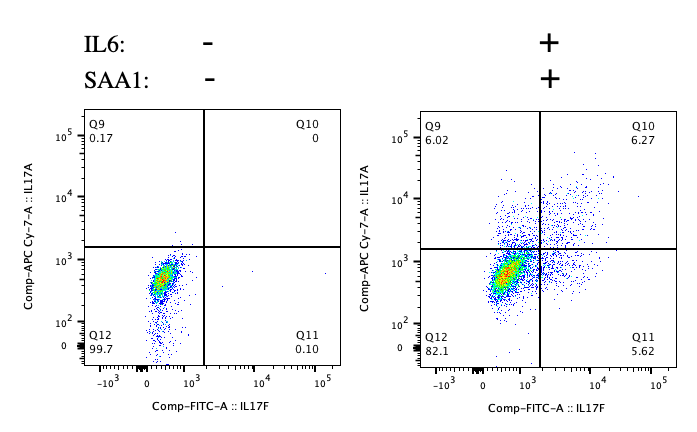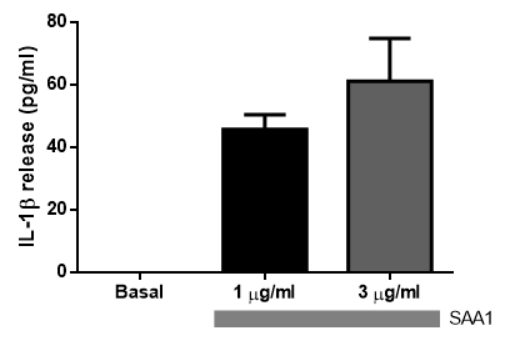Recombinant Mouse Serum Amyloid A1 Protein, CF Summary
Product Specifications
The ED50 for this effect is 1.5-7.5 μg/mL.
Gly20-Tyr122
Analysis
Product Datasheets
Carrier Free
CF stands for Carrier Free (CF). We typically add Bovine Serum Albumin (BSA) as a carrier protein to our recombinant proteins. Adding a carrier protein enhances protein stability, increases shelf-life, and allows the recombinant protein to be stored at a more dilute concentration. The carrier free version does not contain BSA.
In general, we advise purchasing the recombinant protein with BSA for use in cell or tissue culture, or as an ELISA standard. In contrast, the carrier free protein is recommended for applications, in which the presence of BSA could interfere.
2948-SA
| Formulation | Lyophilized from a 0.2 μm filtered solution in Tris-HCl, NaCl, PEG and Imidazole. |
| Reconstitution | Reconstitute at 100 μg/mL in PBS. |
| Shipping | The product is shipped at ambient temperature. Upon receipt, store it immediately at the temperature recommended below. |
| Stability & Storage: | Use a manual defrost freezer and avoid repeated freeze-thaw cycles.
|
Reconstitution Calculator
Background: Serum Amyloid A1
Mouse Serum Amyloid A protein‑1 (SAA1; previously SAA2 in mouse) is a multifunctional apolipoprotein produced by hepatocytes in response to pro‑inflammatory cytokines (1 ‑ 4). It is secreted as a 12 kDa, 103 amino acid (aa), nonglycosylated protein and circulates as part of the HDL complex (1 ‑ 4). The SAA1 gene is one of five SAA genes in mouse (3). Mature mouse SAA1 shares 72%, 72% and 67% amino acid (aa) sequence identity with human, rabbit and equine SAA1, respectively. SAA1 and SAA2 share 113 of their 122 amino acids and are termed A‑SAA (acute phase SAA) (2, 3). SAA1 is produced in the liver in both human and mouse (3, 4). SAA1 is prominently produced in human adipose tissue, but is absent in mouse adipose, which instead expresses adipose SAA3 (a pseudogene in humans) (5). In mouse, however, circulating SAA1 is elevated by insulin resistance (6). A‑SAA can increase by as much as 1000‑fold during inflammation (3). When highly expressed, A‑SAA can displace ApoA1 as the major apolipoprotein in HDL complexes, weakening its role as a reverse (lipid clearing) cholesterol transporter (4). A highly charged region of SAA1 and 2 (aa 36 ‑ 68) contains putative fibronectin and laminin binding motifs (3). This region also binds heparan sulfate proteoglycans at mildly acidic pH and promotes aggregation of A‑SAA; however, pathogenic amyloid fibrils contain fragments of mouse SAA2, not SAA1 (3, 7, 8). Mouse strains can differ in SAA sequence, expression, and amyloid formation (1, 8 ‑ 10). SAA1 is a ligand for CD36/SR‑B3, SR‑B1, FPRL1, TLR2, and RAGE on monocytes/macrophages, inducing chemotaxis and generation of cytokines and tissue factor (12 ‑ 14). SAA1 can bind the surface of invading gram‑negative bacteria, acting as an opsonin to aid clearance by macrophages (11). SAA1 also binds platelets, probably by engaging fibrinogen on the platelet surface (15).
- Lowell, C.A. et al. (1986) J. Biol. Chem. 261:8442.
- Yamamoto, K-I. and S. Migita (1985) Proc. Natl. Acad. Sci. USA 82:2915.
- Uhlar, C.M. and A.S. Whitehead (1999) Eur. J. Biochem. 265:501.
- van der Westhuyzen, D.R. et al. (2007) Curr. Opin. Lipidol. 18:147.
- Yang, R-Z. et al. (2006) PLoS Med. 3:e287.
- Scheja, L. et al. (2008) Exp. Diabetes Res. 2008:230837.
- Elimova, E. et al. (2009) FASEB J. 23:3436.
- Yu, J. et al. (2000) Lab. Invest. 80:1797.
- Thorn, C.F. and A.S. Whitehead (2002) Amyloid 9:229.
- deBeer, M.C. et al. (1993) J. Biol. Chem. 268:20606.
- Shah, C. et al. (2006) Blood 108:1751.
- He, R.L. et al. (2009) Blood 113:429.
- Cai, H. et al. (2007) J. Immunol. 178:1852.
- Baranova, I.N. et al. (2010) J. Biol. Chem. 285:8492.
- Urieli-Shoval, S. et al. (2002) Blood 99:1224.
Citations for Recombinant Mouse Serum Amyloid A1 Protein, CF
R&D Systems personnel manually curate a database that contains references using R&D Systems products. The data collected includes not only links to publications in PubMed, but also provides information about sample types, species, and experimental conditions.
4
Citations: Showing 1 - 4
Filter your results:
Filter by:
-
An invasive zone in human liver cancer identified by Stereo-seq promotes hepatocyte-tumor cell crosstalk, local immunosuppression and tumor progression
Authors: Wu, L;Yan, J;Bai, Y;Chen, F;Zou, X;Xu, J;Huang, A;Hou, L;Zhong, Y;Jing, Z;Yu, Q;Zhou, X;Jiang, Z;Wang, C;Cheng, M;Ji, Y;Hou, Y;Luo, R;Li, Q;Wu, L;Cheng, J;Wang, P;Guo, D;Huang, W;Lei, J;Liu, S;Yan, Y;Chen, Y;Liao, S;Li, Y;Sun, H;Yao, N;Zhang, X;Zhang, S;Chen, X;Yu, Y;Li, Y;Liu, F;Wang, Z;Zhou, S;Yang, H;Yang, S;Xu, X;Liu, L;Gao, Q;Tang, Z;Wang, X;Wang, J;Fan, J;Liu, S;Yang, X;Chen, A;Zhou, J;
Cell research
Species: Mouse
Sample Types: Whole Cells
Applications: Bioassay -
Serum Amyloid A1/Toll-Like Receptor-4 Axis, an Important Link between Inflammation and Outcome of TBI Patients
Authors: V Farré-Alin, A Palomino-A, P Narros-Fer, AB Lopez-Rodr, C Decouty-Pe, A Muñoz-Mont, J Zamorano-F, B Mansilla-F, J Giner-Garc, P García-Fei, M Sáez-Alegr, AJ Palpán-Flo, JM Roda-Frade, CS Carabias, JM Rosa, B Civantos-M, S Yus-Teruel, L Gandía, A Lagares, BJ Hernández-, J Egea
Biomedicines, 2021-05-25;9(6):.
Species: Mouse
Sample Types: Whole Cells
Applications: Bioassay -
Bacterial Lipoproteins Constitute the TLR2-Stimulating Activity of Serum Amyloid A
Authors: EJ Burgess, LR Hoyt, MJ Randall, MM Mank, JJ Bivona, PL Eisenhauer, JW Botten, BA Ballif, YW Lam, MJ Wargo, JE Boyson, JL Ather, ME Poynter
J. Immunol., 2018-08-29;0(0):.
Species: Human
Sample Types: Whole Cells
Applications: Bioassay -
High-density lipoprotein inhibits serum amyloid A-mediated reactive-oxygen species generation and NLRP3 inflammasome activation
Authors: P Shridas, MC De Beer, NR Webb
J. Biol. Chem., 2018-07-05;0(0):.
Species: Mouse
Sample Types: Whole Cells
Applications: Bioassay
FAQs
No product specific FAQs exist for this product, however you may
View all Proteins and Enzyme FAQsReviews for Recombinant Mouse Serum Amyloid A1 Protein, CF
Average Rating: 5 (Based on 2 Reviews)
Have you used Recombinant Mouse Serum Amyloid A1 Protein, CF?
Submit a review and receive an Amazon gift card.
$25/€18/£15/$25CAN/¥75 Yuan/¥2500 Yen for a review with an image
$10/€7/£6/$10 CAD/¥70 Yuan/¥1110 Yen for a review without an image
Filter by:



